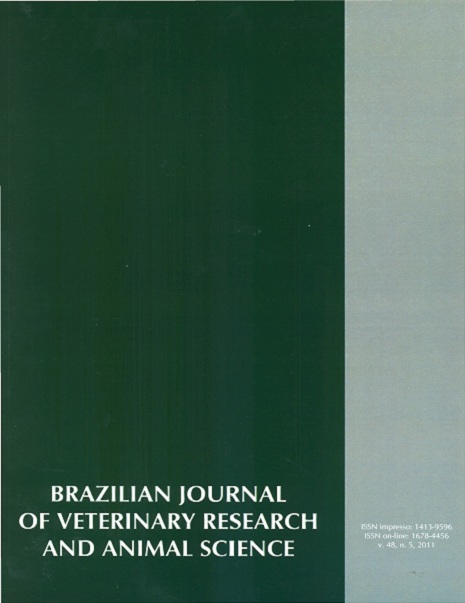Relationship between the use of therapeutic shoeing, period of treatment and rehabilitation of horses with chronic laminitis
DOI:
https://doi.org/10.11606/S1413-95962011000500001Keywords:
Equine, Laminitis, Treatment, Therapeutic shoeing, Foam padAbstract
Data from 138 horses with laminitis treated in the period of ten years were reviewed. Of these, 48 cases of chronic laminitis were selected in order to relate the clinical recovery of horses using two different methods of distribution of body weight on the hooves: foam pad and foam pad associated with shoeing. The horses were divided according to clinical recovery, the weight distribution method chosen and degree of rotation of the third phalange. Also the average time of treatment was established. Considering the degrees of rotation 3-5, 6-8, 9-11 and above 11, and comparing the two methods of distribution of body weight on the hooves, there was no statistical difference in the percentage of animals with clinical recovery. However, 43.5 ± 14% of horses that used foam pad and 69,5 ± 19% of them that used foam pad associated with shoeing recovered clinically. There was no correlation between the increase of the degree of rotation of the third phalanx and treatment time. Clinical recovery of animals was not related to treatment time. Several factors are correlated with prognosis in the literature, but this study demonstrated that the return of the function previously performed by the horse is not related to treatment time, however, is influenced by the use of shoeing.Downloads
Download data is not yet available.
Downloads
Published
2011-10-01
Issue
Section
UNDEFINIED
License
The journal content is authorized under the Creative Commons BY-NC-SA license (summary of the license: https://
How to Cite
1.
Oliveira TM, Pereira MMF, Silva LCLC da, Fernandes WR, Baccarin RYA. Relationship between the use of therapeutic shoeing, period of treatment and rehabilitation of horses with chronic laminitis. Braz. J. Vet. Res. Anim. Sci. [Internet]. 2011 Oct. 1 [cited 2024 Apr. 16];48(5):355-60. Available from: https://www.revistas.usp.br/bjvras/article/view/34400





